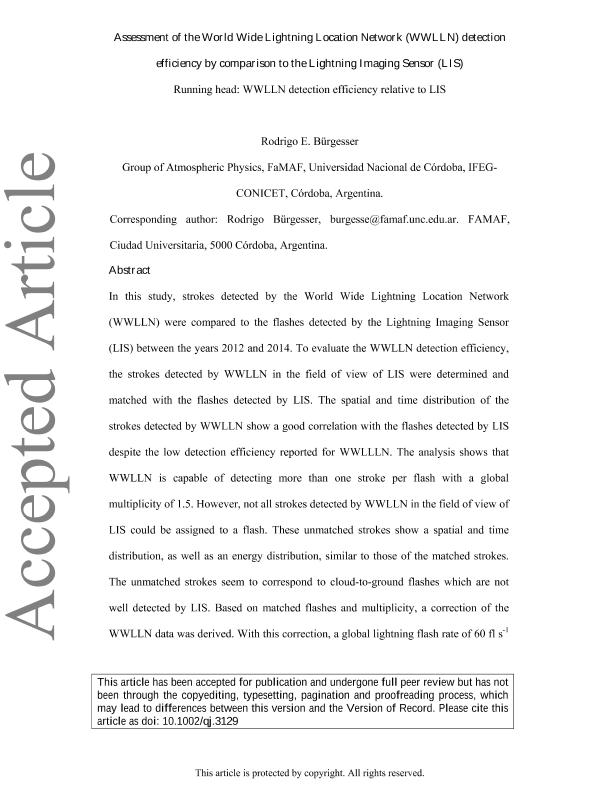Artículo
Assessment of the World Wide Lightning Location Network (WWLLN) detection efficiency by comparison to the Lightning Imaging Sensor (LIS)
Fecha de publicación:
10/2017
Editorial:
John Wiley & Sons Ltd
Revista:
Quarterly Journal of the Royal Meteorological Society
ISSN:
0035-9009
e-ISSN:
1477-870X
Idioma:
Inglés
Tipo de recurso:
Artículo publicado
Clasificación temática:
Resumen
In this study, strokes detected by the World Wide Lightning Location Network (WWLLN) were compared to the flashes detected by the Lightning Imaging Sensor (LIS) between the years 2012 and 2014. To evaluate the WWLLN detection efficiency, the strokes detected by WWLLN in the field of view of LIS were determined and matched with the flashes detected by LIS. The spatial and time distribution of the strokes detected by WWLLN show a good correlation with the flashes detected by LIS despite the low detection efficiency reported for WWLLLN. The analysis shows that WWLLN is capable of detecting more than one stroke per flash with a global multiplicity of 1.5. However, not all strokes detected by WWLLN in the field of view of LIS could be assigned to a flash. These unmatched strokes show a spatial and time distribution, as well as an energy distribution, similar to those of the matched strokes. The unmatched strokes seem to correspond to cloud-to-ground flashes which are not well detected by LIS. Based on matched flashes and multiplicity, a correction of the WWLLN data was derived. With this correction, a global lightning flash rate of 60 fl s-1 was obtained and a map of the corrected flash density detected by WWLLN was performed. The spatial distribution of WWLLN multiplicity and detection probability are available for the community.
Palabras clave:
Detection Efficiency
,
Lightning
,
Lis
,
Wwlln
Archivos asociados
Licencia
Identificadores
Colecciones
Articulos(IFEG)
Articulos de INST.DE FISICA ENRIQUE GAVIOLA
Articulos de INST.DE FISICA ENRIQUE GAVIOLA
Citación
Burgesser, Rodrigo Exequiel; Assessment of the World Wide Lightning Location Network (WWLLN) detection efficiency by comparison to the Lightning Imaging Sensor (LIS); John Wiley & Sons Ltd; Quarterly Journal of the Royal Meteorological Society; 143; 708; 10-2017; 2809-2817
Compartir
Altmétricas




